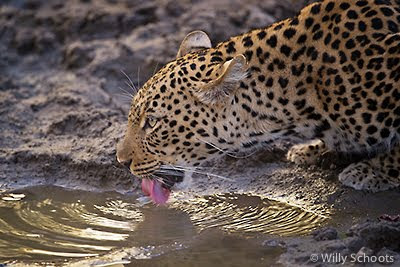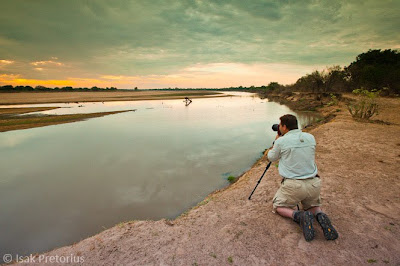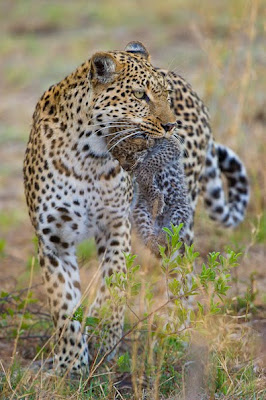
We got special permission to leave before sunrise so we could utilize the best light in the morning. This meant that our wake up call was at 4.15am every morning and that we left at 5.00am. The first day we got our first impression of the South Luangwa valley and its wildlife. One of the favourites for most if not all of us was the Carmine Bee-eater colony. Hundreds of birds flew on and off the nests to feed their chicks. We got some great tips on how to shoot these very fast birds, the key was to use a high shutter speed (1/2500s) and to use manual metering as the background could change during their flight pattern. We visited this colony multiple times during our stay.
After our morning drives we arrived back at the lodge for our brunch around 11.30. The food at the lodge was excellent and the brunch buffet was no exception. Till about 2pm we had time to sleep, download images, and shower etc. In the afternoon we got some great lectures from Isak about different aspects of nature photography. Topics he covered were technical details (expose, shutter speed, aperture), composition, lightroom basics (library and develop module). Beside these lectures we were also encouraged to share some of our pictures for an informal review. During this review we could see how we each took great pictures at the different sightings. I especially findi it very useful to see the different approaches everyone takes at the same sighting.
At 4pm it was tea time at the lodge and we got ready to go out into the park again. One of the cool things we could do in the South Luangwa park is to extend our evening game drive into a "night" drive as we could stay out till 8pm (sunset was at 6pm). It was a nice experience to drive around in the dark trying to find the more nocturnal animals. We did also see some more elusive creatures like the genet, the porcupine, and some bushbabies.

During the second evening we got our chance to photograph a Leopard drinking with some nice late evening light. South Luangwa is renowned for its leopard sightings and we were not disappointed as in total we probably saw 3 leopards, some at multiple sightings.
Of course while staying at the Puku Ridge lodge we saw our fair share of Puku's but also a lot of Impala's. After seeing a pair of lions starting their mating rituals we drove off and one Puku male gave us a great portrait session. He stood nicely on the top of a little bank and let us shoot as many pictures as we wanted. He even looked in different directions to give us the shot we were looking for. It was the first time I saw Puku's so I was very happy to take his picture with a nice clean background.

Everyone was hoping to see a kill from one of the bigger predators in the park like lions, leopard or hyena's. We did see some feeding on a hippo carcass by a leopard and some lions. However we only witnessed a kill from a much smaller predator as we saw a Yellow-bellied Sand Snake devour a frog. We were focusing on the landscape and we would have missed it if not for our great guide Malemia spotting this grim scene below us.

During the workshop we tried to utilize different techniques to improve our photographic skills. Both Isak and Hilton encouraged us to use things like flash, panning and wide-angle shots. If needed we could borrow flash units or lenses from our tour leaders to get us to try these options. Hilton even ran for one group to give them a target to practice their panning shots!!! I'm still not a big fan of flash in nature photography but I do see the usefulness of it in certain situations. I took a shot of a juvenile Carmine Bee-eater with off camera flash and I must admit I do like the result.

Unfortunately after 4.5 days of game drives it was time to go back home. Luckily we had a bunch of great pictures to remind us of this magical place. The last morning we had a great sunrise with a willing Hippo and we visited the carmine bee-eater colony for the last time. After our brunch we were on our way back to the real world in Johannesburg and beyond.

I had a excellent time during this workshop and I would like to thank my fellow participants Barbara, Judith, Heike, Vicky and Rudy for being great companions. To both Isak and Hilton a big THANK YOU for all the support during the game drives and the lectures. To all the personel at the Puku Ridge lodge for making our stay so pleasant. Especially to Don and Suku for their hospitality and for the excellent guiding by Joseph and Malemia.
Till next time !!!
Read more...













































